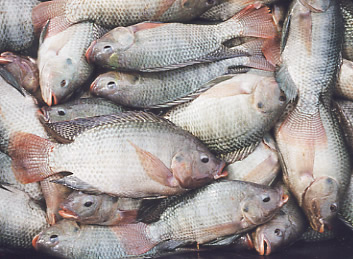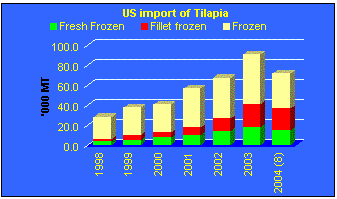|
-
Several business opportunities - component parts of the Integrated Developing Scheme described in Africans, Stop Being Poor! are listed in following table.
| a-
SHEA BUTTER (5,
6, 7,
11, 12,
13)
b- BLUE GOLD (14,
15, 16,
17, 18,
19)
c- FREEZE-DRIED PAPAIN (20,
21, 22
and here)
d-
KENAF (23,
24)
e- VEGETABLE OIL (25,
26, 27,
28)
f- CEREALS (30,
31, 32,
33)
g- FRUITS (34,
35, 36,
37, 38,
39, 40,
42, 43,
44, 45,
46)
h- ESSENTIAL OILS (47,
48, 49,
50, 51,
52)
i- ROOTS & TUBERS (54,
55, 56,
57, 58,
59, 60,
61, 62,
63, 64)
j-
FOWL BREEDING (66,
67, 68,
69, 70,
71, 72, 73, 74, 75, 76)
k- FISH FARMING (78, 79, 80, 81, 82, |
| CLICK HERE TO PURCHASE AD INSERTION AT THIS POSITION |
-
FISH FARMING AS BUSINESS OPPORTUNITY: PART
IV - TILAPIA: A PEFECT FISH SPECIE TO SETUP INCOME BUILDING OPERATIONS FOR AFRICAN RURAL FOLKS
In anticipation to the Economics of a Small-Scale Fish-Farming Operation based on the polyculture of Tilapia and Catfish, we shall, in this issue, further consider Tilapia's breeding characteristics and potential market - worldwide.

- SOME TILAPIA FISH-FARMING CHARACTERISTICS
Tilapia is "extremely" resistant to viral, bacteriological and fungal diseases than other aquaculture species. It tolerates a wide range of salinity, and relish in "warm" water at temperatures between 29�C and 31�C. Growth rates decline rapidly at temperatures below 20�C.
Further, and very important for breeding conditions existing in tropical sun-drenched areas, Tilapia tolerates lower levels of dissolved oxygen (DO) concentrations less than 0.5 mg/l, which is below the tolerance levels for most cultivable fish.
Tilapia consumes a wide variety of food including plankton, green leaves, benthic organisms, aquatic invertebrates, larval fish, and detritus and decomposing organic matter - In south East Asia duck droppings are used to fed tilapia.
Tilapia matures fast and is a prolific specie. Therefore, one has to control population size in pond to avoid stunted growth due to overcrowding - particularly in polyculture operations. Cage culture prevents overcrowding, as the females cannot recover the eggs for oral incubation.
All male culture prevents spawning and better yield as males grows faster. [Males in general demonstrate a growth rate 40% faster than that of females.] All male fingerlings are produced using sex reversal techniques or by manually separating sexes.
It takes about 8-10 months to bring tilapia to a marketable size (compared to 2-3 years for salmon); and the fattening period could be shorten to 6 months in All males' breeding or controlled-population's 'operations - to obtaining market size in the range of 400 to 500g for whole fish and 700 to 1000g (11 to 14 months old) for production of processed fillets. [Source]
- POSSIBLE FINGERLING SUPPLY' SOURCE
There are research stations around African continent specialized in fingerling production for Tilapia - Particularly in Egypt, and South Africa.
On the international marketplace Taiwan's tilapia industry is a good supply' source; Wageningen University in Holland and tilapiaseed.com in the United States of America are other reliable sources that provide information on warm water fishing techniques. Tilapiaseed.com for instance provides the following Tilapia fingerlings lines:
· Egyptian Nilotica Ismailia Canal (Pure)
· Egyptian Nilotica Lake Manzallah (Pure)
· Israeli/Jordan Aurea (Pure)
· White Aurea (Line)
· Red Tilapia-Florida, Jamaica, Israel, Indonesian (Lines) |
- TILAPIA MARKET SIZE IN AFRICAN COUNTRIES AND WORLDWIDE
In most African countries, there are, here and there, research stations on fish-farming development. But sadly enough, such researches had not resulted into full promotional activities to establish Tilapia as protein provider for the populations.
Indeed,
currently (end of 2005) not a single sub-Saharan African country had a promotion plan for the extensive culture of Tilapia. One could therefore consider the African market for Tilapia to be potentially a huge one for whole fresh product and transformed products such as smoked and sun-dried tilapia.
Considering an intake of one (the strict minimum) whole tilapia per African, per month, one could estimate the market size to be in the range of minimum 3,264,000 metric ton a year. [400g x 680,000,000 (Africans) x 12 (months)]. Imagine what the potential would be if one consider a daily intake of one whole tilapia fish per inhabitant! could estimate the market size to be in the range of minimum 3,264,000 metric ton a year. [400g x 680,000,000 (Africans) x 12 (months)]. Imagine what the potential would be if one consider a daily intake of one whole tilapia fish per inhabitant!
There is also an ever growing international market as shown by the import trend for the United States of America (see graphic on the right).
Due to the "extraordinary" prolificness of Tilapia, it could be considered as a perfect Income Building Power for rural communities in African countries. That is It could provide cash on a sustainable basis to rural folks throughout Africa.
Based on previous deliveries' contents, the next issue (February 15, 2006) will further consider Catfish's breeding characteristics - in anticipation to the exposure of the investments about a small-scale polyculture operation based on Tilapia and Catfish in African countries.
Adobe
Acrobat Reader is available here
- Interested parties - private African and international investors /
companies, government
agencies,
international development
agencies - to make contact through the Free Access Support Console available at this link
Contact through the support console will get quickest reply from Africabiz Online's staff, than contact by emails. Click here for contact information. Be advised that first contact should be through the support console to be followed by phone calls. If you are a VIP-Member, use VIP-Members Support Console available here.
Before you consult please click
here to review this clarification |

